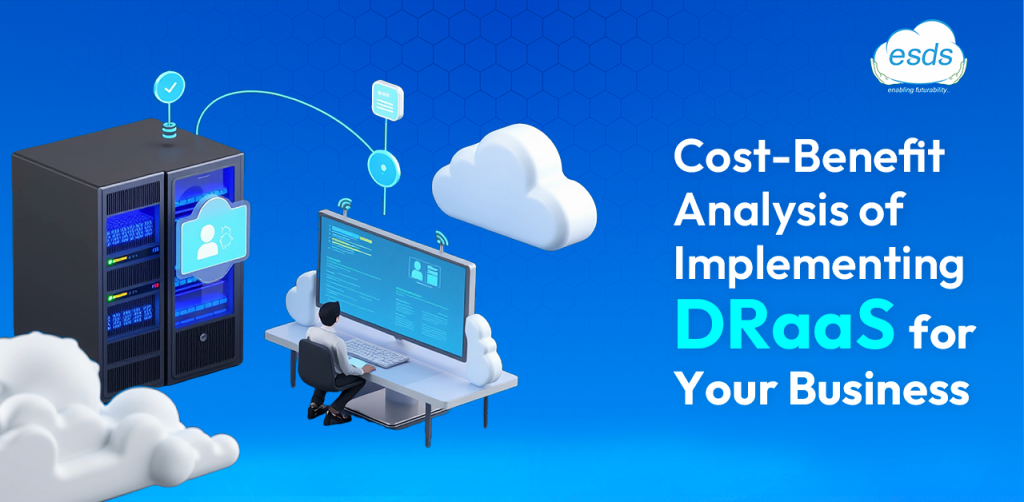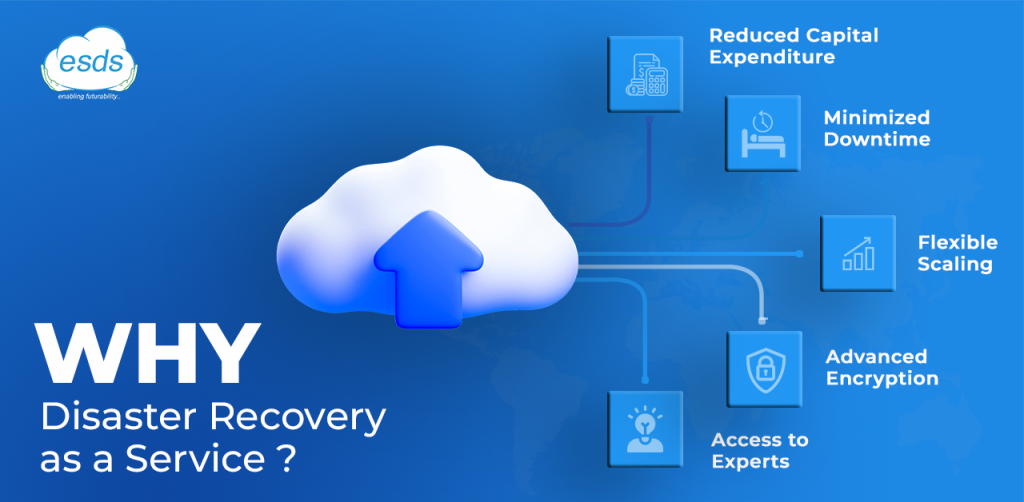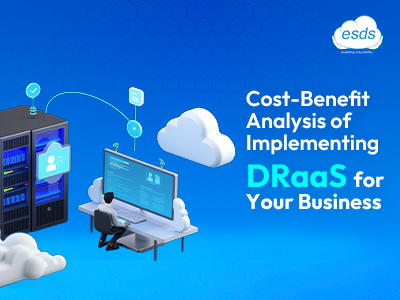Cost-Benefit Analysis of Implementing DRaaS for Your Business

The consequences of data breaches have never been unambiguous, and businesses should pay attention to the robustness and accessibility of their data. Growing dependence on digital frameworks in organization operations has made Disaster Recovery solutions more critical than ever. Earlier, companies have benefitted from classic disaster recovery solutions, but with the emergence of Disaster Recovery as a Service or DRaaS, businesses are in a much better position. This blog will go through a detailed cost comparison analysis of DRaaS against conventional disaster recovery techniques and how DRaaS services can be of immense value to organizations, regardless of their size.
Understanding DRaaS and Traditional Disaster Recovery
Traditional Disaster Recovery:
Traditional disaster recovery typically involves maintaining a secondary physical data center that mirrors the primary one. Businesses can switch to this secondary site in a disaster to continue operations. This method often includes cold backups, hot and warm standby systems, and manual failover processes.
Disaster Recovery as a Service (DRaaS):
DRaaS is a cloud-based solution that replicates and hosts your critical data and IT infrastructure on the cloud. It allows companies to protect vital systems and information by copying it offsite. In the event of disasters such as fires, floods, or power outages disabling the primary systems, DRaaS provides swift switching to the duplicated surroundings stationed in the cloud. This enables businesses to restart dealing with clients again right away. DRaaS presents diverse tiers including blazing speed, still warm, and amiable cold recovery alternatives that satisfy assorted recovery time and point objectives for information restoration. The blazing speed choice synchronizes information continuously for the speediest recovery whereas the laidback cold choice backups information less often with a slower recovery.
Cost-Benefit Analysis of DRaaS vs. Traditional Disaster Recovery

1. Upfront and Operational Costs
The primary financial burden of traditional disaster recovery lies in the significant upfront costs. Businesses must invest in a secondary data center’s physical infrastructure, including servers, storage, and networking equipment. The operational costs include maintenance, power, cooling, and staffing for the secondary site. Over time, these expenses can escalate, making traditional disaster recovery expensive.
DRaaS, on the other hand, eliminates the need for a secondary physical site. Since DRaaS operates in the cloud, businesses can save costly upfront investments in hardware and infrastructure that traditional disaster recovery requires. Rather than paying large sums upfront for hardware, DRaaS uses a subscription model where businesses only cover resources utilized. Such flexibility considerably trims initial capital expenses while ongoing operational costs remain predictable. Moreover, DRaaS furnishes the adjustability to modulate cloud provisions by fluctuating business needs, enhancing value. The pay-as-you-employ design streamlines output to optimize resource use hand-in-hand with affordability. Altogether, DRaaS carves a smoother trajectory toward resilience for outfits of any size.
2. Scalability and Flexibility
To Scale a traditional disaster recovery infrastructure it can be challenging and costly. Expanding the capacity of a secondary data center requires additional investments in hardware, space, and personnel. Moreover, scaling down in response to changing business needs can result in underutilized assets, leading to wasted resources.
DRaaS solutions offers unparalleled scalability and flexibility so Businesses can quickly scale their disaster recovery resources up or down based on their requirements of the situation. Whether adding more storage, increasing computational power, or extending to additional locations, DRaaS provides the agility to adapt to changing circumstances.
Imagine a mid-sized enterprise experiencing rapid growth and expansion into new markets. Under a traditional disaster recovery model, this business must invest heftily in expanding its secondary data center. However, with a reliable DRaaS service provider, the company can effortlessly scale its disaster recovery resources to accommodate the growth, ensuring that new data and systems are protected without additional physical infrastructure.
3. Recovery Time Objective (RTO) and Recovery Point Objective (RPO)
Traditional disaster recovery methods often involve longer RTOs and RPOs, especially if manual failover processes are in place. The time required to bring the secondary data center online, restore data, and resume operations can vary depending on the complexity of the setup. This delay can result in extended downtime and potential data loss, which can have severe financial and reputational impacts.
DRaaS significantly reduces RTOs and RPOs by leveraging automated failover processes and cloud-based replication. ESDS’s DRaaS solutions offer multiple tiers Hot DR, Warm DR, and Cold DR—each tailored to meet specific RTO and RPO requirements. For instance, Hot DR ensures immediate failover with near-zero data loss, making it ideal for mission-critical applications. Customizing RTO and RPO according to business needs protects that traditional methods may struggle to match.
Consider a financial services company that requires high availability and minimal downtime due to the critical nature of its operations. Traditional disaster recovery methods might not meet the stringent RTO and RPO requirements, potentially leading to financial losses and customer dissatisfaction during a disaster. By implementing a Hot DR solution, the company can achieve immediate failover with zero data loss, ensuring that operations continue seamlessly even in the face of a disaster.
4. Maintenance and Management
Maintaining a traditional disaster recovery setup requires ongoing management, monitoring, and regular testing to ensure readiness. This can be resource-intensive, requiring dedicated personnel and time. Additionally, updates and upgrades to the infrastructure can further complicate the maintenance process.
DRaaS simplifies maintenance and management by shifting the burden to the service provider. That offers DRaaS solutions which include regular testing, monitoring, and updates as part of the service, ensuring that disaster recovery plans are always up-to-date and functional. This allows businesses to focus on their core operations without the distraction of managing complex disaster recovery infrastructure.
Managing a traditional disaster recovery setup could be overwhelming and prone to errors for a small business with a limited IT staff. Businesses must choose a DRaaS service provider that helps businesses offload maintenance and management responsibilities, ensuring that disaster recovery plans are always ready without straining internal resources.
5. Return on Investment (ROI)
The ROI for traditional disaster recovery can be difficult to justify, especially for businesses that do not experience frequent disasters. The high costs of maintaining a secondary data center and the potential for underutilized assets can result in a lower ROI.
DRaaS offers a higher ROI by providing cost-effective disaster recovery solutions that scale with business needs. The pay-as-you-go model ensures that businesses only pay for the resources they use, maximizing cost efficiency. Additionally, the ability to quickly recover from a disaster with minimal downtime and data loss translates to tangible financial benefits, including reduced operational disruptions and preserved revenue streams.
A manufacturing company that implemented DRaaS to protect its critical production data. Over five years, the company experienced several instances where DRaaS was activated due to natural disasters and cyberattacks. Each time, the company was able to resume operations quickly, minimizing losses and maintaining customer trust. The cumulative cost savings and business continuity ensured a high ROI, far outweighing the costs of the DRaaS subscription.
Conclusion
The cost-benefit analysis shows that adopting Disaster Recovery as a Service (DRaaS) offers superior value to traditional disaster recovery methods. From reduced upfront and operational costs to enhanced scalability, flexibility, and faster recovery times, DRaaS empowers businesses to protect their operations without traditional approaches’ financial and logistical burdens. ESDS‘s DRaaS solutions, with their tiered offerings and comprehensive support, provide businesses with the tools they need to ensure business continuity, minimize downtime, and achieve a higher return on investment.
For IT Managers, CIOs, business owners, and IT professionals seeking a reliable and cost-effective disaster recovery solution, ESDS DRaaS is the clear choice to safeguard your business against any disaster scenario.
- Security Operations Center (SOC) Services: A Measured Approach to Digital Threat Management - April 11, 2025
- The Impact of AI on Colocation Services - February 13, 2025
- Colocation Data Centers the Backbone of Modern Business Data Management - November 12, 2024
